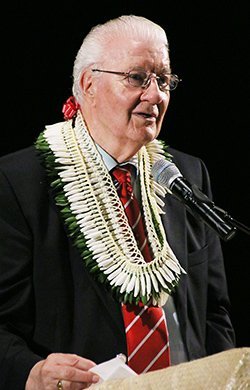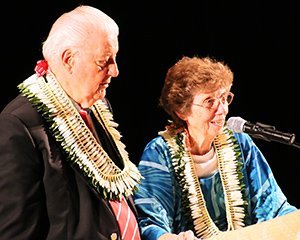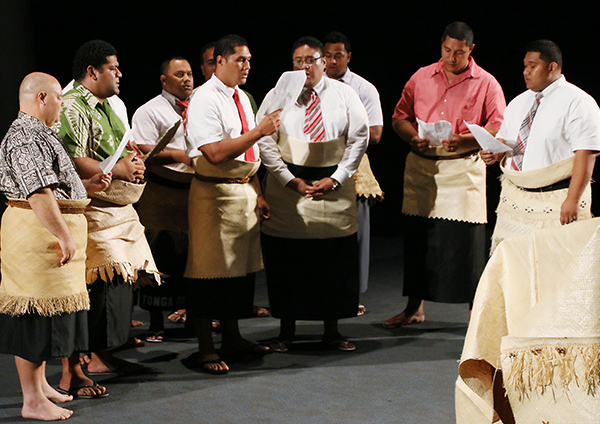
About 60 years ago it took a young Mormon missionary from Idaho more than three months to travel from the Intermountain West to the remote northern Tongan island of Niuatoputapu. There, Elder John H. Groberg — known as Kolipoki, the Tongan transliteration of his last name — and his companion, the late Feki Pō‘uha, overcame a series of amazing situations and challenges that eventually became the subject of the feature film The Other Side of Heaven.
Elder Groberg, now an emeritus General Authority of The Church of Jesus Christ of Latter-day Saints, commented on some of those experiences and others on October 21, 2016, as the keynote speaker for the opening session of the Mormon Pacific Historical Society’s annual conference in the Polynesian Cultural Center’s Hawaiian Journey Theater.
| Kolipoki: Elder John H. Groberg
|
The theme of the MPHS conference was the formal centennial of the Church’s Tongan Mission (1916-2016), although Elder Groberg and other presenters pointed out the Samoan Mission initially sent missionaries to Tonga in 1891, who left in 1897, and again from 1907 until the Church officially organized the Tongan Mission in 1916.
Elder Groberg’s address was originally scheduled to be held in the PCC’s Tongan Village, but PCC managers moved it to the enclosed theater due to threatening weather. Many of the more than 500 people in the audience that evening were Tongans dressed in traditional clothing. Many knew him personally as Kolipoki.
He explained that President Thomas S. Monson of The Church of Jesus Christ of Latter-day Saints encouraged him to write an autobiography of his first mission to Tonga (1954-1957), which was published in 1996 as Eye of the Storm. Director Mitch Davis optioned the book and brought out the Church-approved movie in 2001. In it, Kolipoki faced the challenges of learning the Tongan language, opposition to his preaching, hunger, life-threatening sickness and pain, the death of a local friend, a hurricane and more.

Actor Christopher Gorham portrayed the personable young Elder Groberg; soon to break out star Anne Hathaway portrayed his future wife, Jean Sabin (who accompanied her husband to Laie); and Joe Folau, a Tongan from New Zealand, acted as Feki. Davis shot the film in New Zealand and substituted Rarotonga in the Cook Islands for the Tonga scenes.
| Elder John and Sister Jean Groberg |
The real Feki later came to Hawaii to serve as a labor missionary working on the BYU–Hawaii campus and the Polynesian Cultural Center. His son and grandson, who now live in Hawaii, have also worked at the PCC.
Asked how he felt about being sent to such a remote location and going through trying conditions, Elder Groberg responded, “I honestly felt I was where I was supposed to be. [Also], back then, you didn’t live in Tonga without going hungry many times.” He quickly added this is not the case today.
“People often ask, did you really learn the language in a few days? And the answer is yes and no: No in the sense that I didn’t understand all the language… I still had to work hard for a long time. The yes part is that before that ‘sojourn in the wilderness,’ I really was not very confident I could learn the language. At the end of that time, I absolutely knew that I could… [and] learning the language was an absolute necessity.” Elder Groberg also said he was fortunate to have had a “a very, very good companion.”

“The great blessing of Tonga, in one respect, besides the number of people who are members of the Church, is the great opportunity it has allowed hundreds of others like me to learn something that we probably wouldn’t have learned as well,” Elder Groberg said in an earlier part of his address, “and that is how to love, serve, sacrifice, and yes, how to stay alive physically and spiritually.”
|
Members of the BYU-Hawaii Tongan Club and others sang Tongan missionary music for the MPHA opening session at PCC |
We’re all brothers and sisters,” Elder Groberg concluded. “We all have legacies, but for you who have that [Tongan] heritage, I want you to know that you have a responsibility to not let it die or even wane.”
In addition to serving as a young Latter-day Saint missionary in Tonga, Elder Groberg and his family returned in 1966 when he became the mission president there; and later as a General Authority of the Church he served in various Pacific island capacities, as well as in Hong Kong, Argentina and other places.
Story and images by Mike Foley
 |
Mike Foley, who has worked off-and-on
at the Polynesian Cultural Center since 1968, has been a full-time freelance writer and digital media specialist since 2002, and had a long career in marketing communications and PR before that. He learned to speak fluent Samoan as a Mormon missionary before moving to Laie in 1967 — still does, and he has traveled extensively over the years throughout Polynesia and other Pacific islands. Foley is mostly retired now, but continues to contribute to various PCC and other media.
|

Recent Comments